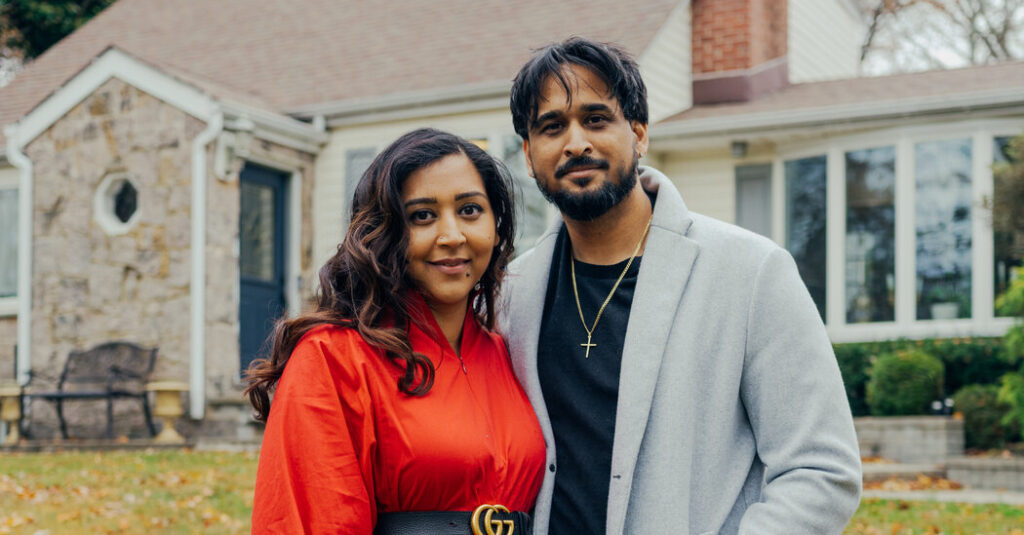When Sandy Lachhman and Shaun Parmassar started house-hunting on Long Island in early 2022, buying a home felt like a race against time.
Mortgage rates were ticking up from record lows, and listings seemed to disappear quickly. Both had new jobs — Ms. Lachhman as a hospital operations manager and Mr. Parmassar in cybersecurity — and were eager to lock in a deal while they still could.
After spending almost every weekend for three months looking at houses, the couple secured a two-bedroom, two-bathroom home with a pool, paying around $660,000, about $30,000 over asking price, at a 4 percent interest rate.
“The way the housing market was during the pandemic, it gave millennials such as myself a very good opportunity to get into the housing market,” said Ms. Lachhman. “It would have been a much more difficult process now.”
The couple is still in the house and doing well on paper. Their monthly payment of about $5,000 hasn’t budged, leaving room for savings and entertainment. But life looks different. Now, the couple has a Labrador retriever, an 18-month-old and another baby on the way, and the house feels a lot smaller than it used to.
It’s a dilemma they share with many other Americans who purchased houses during the pandemic: financially grounded, yet physically stuck and unsure how to move forward.
When the world shut down and mortgage rates tumbled, buying a home felt like the ultimate act of security. Americans rushed to buy, some pooling resources with siblings, partners or friends to make it possible. During the pandemic, the 30-year fixed-rate mortgages fell below 3 percent for the first time, and hit a record low of 2.65 percent in early 2021, according to Freddie Mac. For many, that moment felt like a once-in-a-lifetime opportunity.
Those who secured a rate below 3 percent found themselves “a rarity and something we might not see again for a very long time,” said Stephanie Williams, a senior wealth adviser at investment firm AlphaCore Wealth Advisory. And according to a 2023 Realtor.com and HarrisX survey, about 82 percent of homeowners said they felt “locked in” by their low mortgage rate, and more than half were waiting for conditions to improve before selling.
A few years later, some of those pandemic buyers are caught between stability and a desire for change.
“Many people bought their homes in the hopes it was an initial steppingstone on the path to a more ideal property; yet with higher interest rates and more limited inventory, that ‘starter home’ has become a long-term one,” said Courtney Alev, consumer financial advocate at Intuit Credit Karma. “It can leave people feeling trapped.”
Nearly one in four homeowners regret their purchase, according to a recent survey by Intuit Credit Karma, including 38 percent of millennials, who said they underestimated the costs of ownership, and another 40 percent who have postponed other life goals. Add in rising costs and life changes — new partners, children, breakups — and that stability can start to feel more like confinement.
In today’s high-rate, high-price market, many homeowners can’t justify trading their 3 percent mortgage for one that’s twice as expensive, said Jake Krimmel, senior economist at Realtor.com. Yet, many homeowners who want a change aren’t sure whether to rent out their home, sell it or stay put. With President Trump’s recent proposal of a 50-year-mortgage as a way to make home buying more affordable, some feel pressure keep their low-interest, 30-year mortgages.
Stuck in a Starter Home
For Amber McDorman and her husband, buying a home in the suburbs of Phoenix during the pandemic was a mix of luck and timing. They had started looking the year before, but listings came and went in the blink of an eye: One week they were outbid; the next, prices jumped beyond their budget.
Then mortgage rates began dipping below 3 percent, and things started looking up. With a 2.5 percent interest rate, the McDormans secured a three-bedroom home for around $260,000 in 2020. Five years later, they’re still paying $1,300 a month, and their equity has soared by 65 percent.
Back then, the home felt perfect for two people with one child. But they have added a second child to their family, and both work primarily from home, often sharing the same office. The couple would love more space but can’t bring themselves to trade their mortgage for today’s higher rates and home prices. Adding an extension for another bedroom or office could cost up to $50,000, Ms. McDorman said.
“I honestly feel like we’re kind of the lucky ones,” said Ms. McDorman, a social worker in her late 30s. “But we didn’t intend for this to be our forever home.”
Moving — at a Cost
Lissette Debord and her husband decided to sell the starter home they purchased during the pandemic instead of staying in a place they’d outgrown. They bought the house in 2020 in Sussex County, N.J., when they were both 21, during Ms. Debord’s last semester of college, using money they saved by having a virtual wedding on Zoom to secure a 2.7 percent interest rate. The couple was able to afford the $250,000 two-bedroom home through a combination of personal savings, bank loans and first-time home buyer benefits.
The pandemic made them rethink their priorities.
“Like, ‘Are we going to invest in one day, or are we going to invest in something that’s going to build our future?’” said Ms. Debord, who is now 26 and works as an analyst at an executive recruiting firm.
Last year, with their first child, they moved into a larger home in Jefferson County, N.J., gaining an extra bedroom and more space. The trade-off was steep: Their new mortgage is now more than double the old one, and has a 6.6 percent interest rate.
Now, with another baby on the way, the higher payments have reshaped their lives. Ms. Debord and her family have had to cut back on outings and vacations, and must budget more carefully while managing child care and other household costs.
“We took a chance,” Ms. Debord said. “It is what it is now.”
Starting Over in the Same Home
Ja’nise Johnson, 41, bought a four-bedroom home in Tampa, Fla., in 2019, securing an interest rate of around 3 percent. She had a job in insurance for seven years, but when the pandemic hit in 2020, she was furloughed, making it hard for her to keep up mortgage payments while raising three boys as a single mother.
Within the first year, she defaulted on her mortgage. She leaned heavily on friends and family and took side gigs like DoorDash to make ends meet. But she didn’t want to give up the home, wanting to maintain stability for her three children.
Last year, because she was behind on payments, she had to refinance her mortgage for a higher rate of 5.3 percent. That increased her monthly payments to $2,800 from $1,700, limiting her financial flexibility and ability to move.
Yet Ms. Johnson’s biggest regret isn’t buying the home or staying in it when she couldn’t afford the costs: It is not buying a home sooner.
“I probably would have owned my home by this time,” said Ms. Johnson, who now works as a project manager for a financial services company. “Now, I don’t know how long it’s going to take.”
Kailyn Rhone is a Times business reporter and the 2025 David Carr fellow.
The post They Rushed to Buy Homes During the Pandemic. Now, Some Feel Trapped. appeared first on New York Times.




